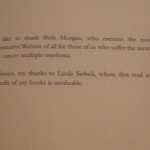My nephew called last night to tell me that he’d had a trip to the ER Monday from work, by ambulance. He became really dizzy, and wasn’t even able to walk. His manager called for an ambulance, and he was taken to the nearest hospital. The ride made him feel even worse, causing nausea and vomiting. After several hours at the hospital, he was told he had vertigo and was allowed to go home. He saw a doctor the next day to make sure there wasn’t anything more he needed to do.
One of his concerns was the bill. As someone who’s been paying medical bills on a continuous basis for over 6 years now, I offered some advice. My advice to anyone who incurs hefty medical bills is to negotiate payments if you’re not able to pay the whole thing at once. I’ve never been turned down by any hospital for a payment schedule, and they have never charged interest. Whatever you do, don’t put the charges on a credit card.
I do have pretty good insurance, but the annual out of pocket expense is up to $3500, depending on how much treatment I have, how many doctor appointments there are, what medications I’m on and if there were any hospital stays. In addition to the maximum out of pocket expense ($3500), there are drug and doctor copays. There are also parking fees and driving expenses. It can add up to a lot, believe me. If I’ve made a trip to the Mayo Clinic or Dana-Farber or someplace, there are even more expenses.
I’m lucky that I have insurance that’ll cover the major stuff. Our plan has no lifetime maximum, and we have good prescription coverage. I don’t think anything I’ve ever done has been challenged by them. I can see specialists when I want to, and only the really big stuff, like the stem cell transplant, has to be pre-approved.
There’s one problem with my insurance. It’s tied to my job. Should anything ever happen to cause me to lose my job, I’d be in big trouble. I’m not old enough to be covered by Medicare and not poor enough to be covered by Medicaid. I’m not elligible for disability, either. I’m an insured middle class person who, like most other working Americans, could easily become uninsured. It’s a situation that can cause worry, because there’s nothing much I could do, except for exhaust my savings and sell my belongings to raise money for treatment if it was needed if, for any reason, I were to find myself uninsured.
I believe we do need to find a solution to address the need for affordale health care for all Americans. I don’t think it’s something that we can keep putting off. The way things are now, the very poor and the elderly get decent health care, and the middle class is left to fend for itself. If employers provide group plans, that’s great, but there are a lot of people who have to pay for their own insurance or have none at all. If you have insurance through your employer and lost your job, how long could you afford to pay the premiums?
I would ask that the people who think we should ignore the problem a while longer try to imagine yourselves jobless and without health care coverage. Then imagine that you have a chronic health condition or serious illness or injury. How will you manage to pay for your treatment or care? What if you can’t even get insurance because of a pre-existing condition?
I usually don’t write about politics, but health care is a hot button issue here. I can’t imagine how any human being can want to deny another person the right to decent, affordable health care. Any of us could find ourselves in need one day.
 I start a creative non-fiction class tomorrow, thanks to my sister, Rachel. She’s encouraged me to git me some more learnin’ so’s I kin write better.
I start a creative non-fiction class tomorrow, thanks to my sister, Rachel. She’s encouraged me to git me some more learnin’ so’s I kin write better.